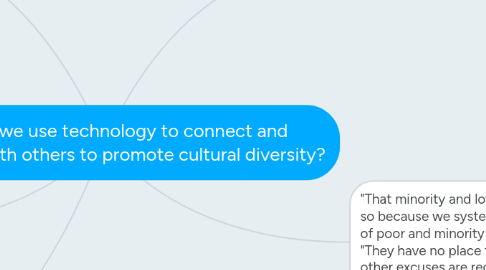
1. Citations
1.1. Diverse Teaching Strategies for Diverse Learners. (n.d.). Retrieved from http://www.ascd.org/publications/books/107003/chapters/Diverse-Teaching-Strategies-for-Diverse-Learners.aspx
1.2. Burris, C. C., & Welner, K. G. (2005, November). Closing the achievement gap by detracking. Phi Delta Kappan, 86(8), 594–598.
1.3. Hodgkinson, H. L. (2003). Leaving too many children behind: A demographer's view on the neglect of America's youngest children. Washington, DC: Institute for Educational Leadership
1.4. Cail, C. (n.d.). wp1.html. Retrieved from http://mste.illinois.edu/courses/ci407su02/students/cail/wp1/wp1.html
2. Sherman Oaks Elementary Charter Schools in Sherman Oaks, CA
2.1. demonstrates how technology should be used and how easily accessible it should be
2.2. Computers are a part of the classroom and are used to enhance learning.
2.3. project-based learning using technology
3. Ways to integrate technology
3.1. webpage design
3.1.1. After students conduct research they could create a webpage; it might include pictures, articles, and their personal artwork.
3.2. internet
3.2.1. Teachers gather resources, create a webpage and the students can do research from that particular site only. It can also be used for communication between schools and communities.
3.3. e-mail
3.3.1. Teachers connect students with e-pals from around the world, can be used for peer tutoring
3.4. electronic portfolio
3.4.1. Students submit samples of their work online, parents can also view the work, too.
3.5. technology literacy
3.5.1. Teachers teach students technological terms (scroll, cursor, browser, log in, and log out, etc. . .)
3.6. video conferencing
3.6.1. A webcam can be used to bring classes together to talk about diversity. Students could also do interviews, give a presentation, and show their artwork.
3.7. word processing
3.7.1. Powerepoint would be used as a culminating activity. Students can include graphs, table, pictures, and information.
4. ". . .teaching in a culturally diverse setting requires a different mindset and philosophy"
4.1. Inclusive
4.1.1. take into consideration the culture found in the home
4.1.2. considers and incorporates various modes and styles of learning
4.1.2.1. Goals of learning starting at memorization and all the way to problem solving
4.1.2.2. creative thinking for inquiry and solution seeking
4.1.2.2.1. An example of a cross cultural approach, a lesson on Independence Day when you have several Mexican students. The teacher could compare and contrast USA independence and Mexican Independence.
4.1.3. includes elements from each culture when presenting materials
4.2. Noninclusive
4.2.1. educators think it is too much to deal with
4.2.2. "The culture may impede the progress of the learning, while increased learning sometimes tends to separate the student from his or her culture."
5. "That minority and low-income children often perform poorly on tests is well known. But the fact that they do so because we systematically expect less from them is not. Most Americans assume that the low achievement of poor and minority children is bound up in the children themselves or their families. "The children don't try." "They have no place to study." "Their parents don't care." "Their culture does not value education." These and other excuses are regularly offered up to explain the achievement gap that separates poor and minority students from other young Americans."("Diverse Teaching Strategies for Diverse Learners", n.d"
5.1. Rockville Centre School District in New York instituted detracking
5.1.1. grouping high and low achievers together in all classes
5.1.1.1. gradually eliminated remedial classes and offered more accelerated learning
5.2. Burris and Welner (2005, p. 595) concluded that when "all students—those at the bottom as well as those at the top of the [achievement] gap—have access to first-class learning opportunities, all students' achievement can rise."
5.3. "Hodgkinson (2003) highlighted another model—the Schools of the 21st Century—that regarded students as whole persons in their family context. This "is one of the most successful models for putting together all of the factors … that contribute to the positive academic, emotional, and social development of young children" (p. 14), including (1) school-based programs; (2) strong links between early childhood and schools; (3) strong parental support and involvement; (4) universal access; (5) a focus on children's physical, social, emotional, and intellectual development; (6) strong staff training and development; and (7) a commitment to serving working families. Schools of the 21st Century is now offered in over 1,400 schools in a wide variety of communities across the United States. Although the core components just mentioned are always present, the program is flexible enough to maximize the program's success in the unique "fingerprint" of each community setting."
5.3.1. South Elementary in Missouri
5.3.1.1. On late start days, they meet with their "family" groups. Students are a part of a group of, various ages, of children and one or two teachers. The children meet, talk, and do activities together.
5.3.1.2. P.R.I.D.E. Proud Responsible Individual Displaying Excellence
5.3.1.2.1. The school are partners with the parents. The P.R.I.D.E. is an award given to parents who have shown commitment to their child's education.
5.3.1.3. Teachers communicate with parents through email
5.3.1.4. Students view videos via youtube or other websites
5.3.1.5. Students using the internet to work on typing instructor
